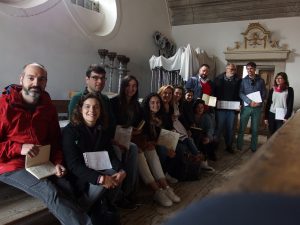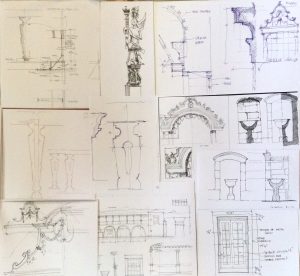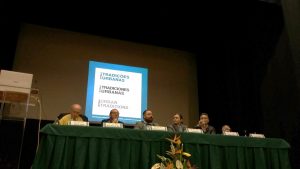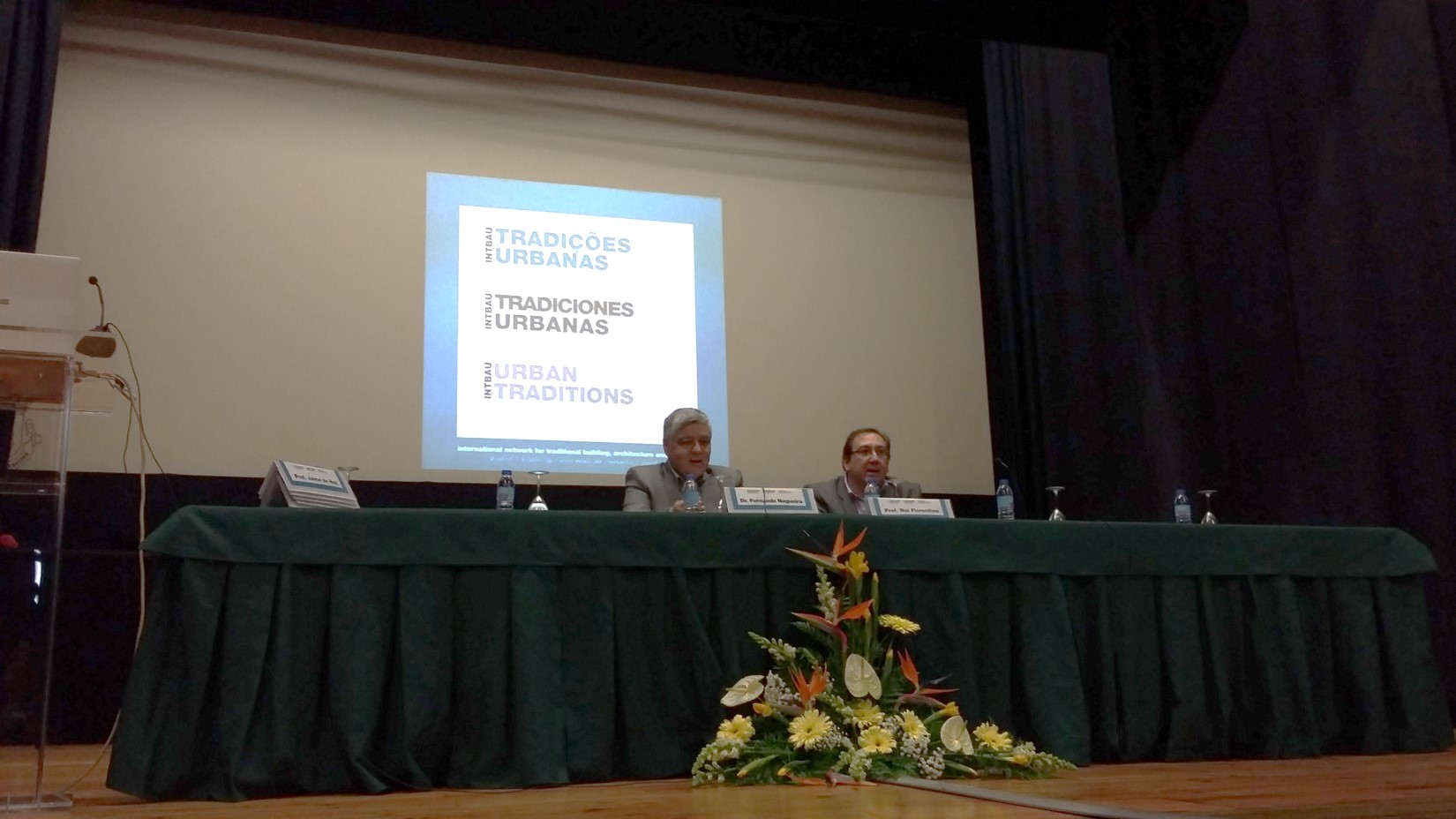The first meeting of the Portuguese and Spanish Chapters of INTBAU was held in Vila Nova de Cerveira (VNC) this past 7, 8 and 9 April.
Work begun on the 7th with an architectural drawing workshop in the historical center of VNC, in which students from the ESG and the Universidade Alfonso X, El Sábio (UAX), from Madrid, participated. The workshop was tutored by the Architects Catarina Santos, Alexandre Castro Gamelas and Pablo Álvarez Funes, as well as ESG Professors Gilberto Carlos and Teresa Correia.
Afterward, the drawings were displayed in the foyer of the Cine Teatro Auditorium, where the Meeting took place the following days. The students had the opportunity to draw historical buildings, paying special attention to architectural composition and constructive typology. The drawings included details as well as measurements and compared proportions, the results of which were very much appreciated by all who attended.
Still on the 7th, at the end of the day, Professor Mariana Correia, ESG’s director, graced the participants with a few opening remarks at the opening cocktail evening.
During the 8th and the 9th the “URBAN TRADITIONS” Symposium was held. Several matters related to traditional Architecture and Urbanism were discussed, from more academic, research-minded orientations to equally diversified practical experiences. The talks were divided into three main sets:
Urban Culture (I); Architecture and Heritage (II) and Urban Landscape (III)
Both Professors and students from different Universities and Research Centers participated, from Portugal and Spain, as well as other INTBAU members and professionals.
On the 8th the Meeting was kicked off with an introduction from the President of the City Council, Dr Fernando Nogueira, and the formal event presentation by Prof. Rui Florentino, member of the board of INTBAU-Portugal and Professor at ESG, who also spoke about INTBAU’s international activity.
Work proceeded then with the first set of lectures entitled “Urban Culture”, moderated by Prof. Jaime de Hoz.
The first talk was by Prof. Sidónio Pardal with the title “Urban culture, territory and society”. Prof. Pardal, a reputable landscape architect with a vastly published and built body of work, delivered an engaging lecture under two principal themes: “Taxonomy and Classification of the Use of Soil” and “the Concept of Landscape”. He defined with clarity the concepts of “category” and ”class”, “urban” and “rustic”, and within the latter “sylvan” and “agricultural”. He also expounded on the concepts of “occupation”, “utilization” and “function” demonstrating, with his pragmatic and systematic thought process, how all these notions are justified. Finally he elaborated on the idea of landscape and showed images of his ample and outstanding work.

Architect Pablo Álvarez Funes then presented an equally very interesting talk – and, with few exceptions, very different to what is usual in this type of symposiums in Portugal and Spain. Showing recent examples of the work his current office develops, he clarified concepts and stressed some aspects of this portfolio, markedly traditional, in its classical or vernacular expressions. He focused on the contrast between “show-architecture” and traditional Architecture with expressive examples. Furthermore, pretense traditional “Architectures” were exposed as ignoring good composition rules and producing low quality buildings of dubious aesthetic value.
Pablo continued explaining on the importance of conforming design work to the different cultural and geographical contexts in which it is located. He stressed the need to deeply study the site, and of respecting the variety and diversity of local traditions in order to save their singularities and identities – which can easily be lost in an ever more standardized and generic world.
Jesus Conde-Garcia presented next a study on several forms of territorial representation – different types of maps – including very curious examples of mental charts, as for instance the ones used by Australian Aboriginals. He has also clarified the concepts of territorial map – as applied to the physical world – and of landscape map – a more cultural concept.
Professor Goreti Sousa presented a synthesis of her investigative work on the territory of the Castro Laboreiro plains in the North of Portugal. She has shown an integrated vision which approaches historical, geographical and social-economical aspects together with their vernacular Architecture expressions. Her methodology of analysis, skillfully developed, demonstrated clearly the ingenuity of Man in his adaptation to an adverse territory, when this adaptation has taken the form of a local built expression.
Engineer Malcolm Millais (INTBAU – Portugal) showed a very well documented and cultivated analysis on the typology of the Georgian row house in Dublin, from an unusual and interesting historical perspective. He manifested a very critical vision on recent interventions on these buildings and urban blocks which, in spite of hardships suffered, still resist. He has compared these with others in similar contexts, in London for example, with Quinlan Terry’s development in Richmond Riverside.
After the morning talks, and an open lunch, work continued during the afternoon with another set of talks under the theme “Architecture and Heritage”, moderated by Arch. Sandro Lopes, of the City Council of VNC.
The first talk, by Prof. Fernando Vela Cossio of the Escola Técnica Superior de Arquitetura de Madrid (ETSAM), a distinguished archeologist and author of countless and excellent investigation projects on these themes, versed on the “National Traditional Architecture Plan” – a project which he has been coordinating, in Spain, and which constitutes a remarkable and exemplary tool for its holistic approach and integral vision.
Afterward Prof. Mariana Correia, director of the ESG, discussed the investigation which, together with Prof. Gilberto Carlos, has been carried out in recent years on Traditional Architecture and Urbanism, more specifically in their vernacular expressions. Among the many topics considered, two stood out. The first was an analysis on the seismic resistance in this type of buildings. The second touched on the scope of teaching methods, its tools and instruments – a very important and current debate, of which we heard, later on, from Prof. Javier Cenicacelaya.

Architects André Tavares and Inês Pimentel – both with offices in Porto – brought forward, in separate lectures, acomplished examples of building renewal, demonstrating with their work the importance which knowledge in Traditional Architecture, the mastering of its elements from composition to construction, has when applied to buildings being done today. They presented both the methodology and approach which they have adopted on their projects, with profound research on the different factors relevant to the work, respecting, saving and thus adding value to the sites and buildings which were object of their admirable interventions.
Architect Joana Gonçalves presented an excellent exposition on the indissoluble relation between Architecture and Community – a concept which might seem innate, or basic, but which is so often ignored or forgotten nowadays by the agents of transformation in the territory.
Taking as the theme her research on the specificity of the “Terra Fria” houses in the Portuguese region of Trás-os-Montes, she expounded on very current notions such as “tradition in continuity”, among others, and, from here, developed her thesis on “Strategies for Inclusive Interventions on Vernacular Heritage”. We have retained from her speech a particularly curious fragment: “(…) when Traditional Architecture was built in a traditional way” – which in itself would be a good theme to develop in a future meeting.
She has finally spoken about the “barriers” or difficulties facing the development and application of these strategies, to which she counterweights with setting good examples as well as with perseverance and good will. Thus supporting the renovation of traditional crafts in a new perspective, and responding to current challenges.
Architect Pilar Diez showed an exceptional work entitled “Restauración del Património Arquitectónico en Tierra de Campos”, showing once again, through the wonderful examples shown, the enormous advantages of these urban renewal approaches and recuperation of traditional constructive typologies. Not only because they allow us to recover very pleasant and beautiful spaces, but also because they potentiate opportunities for local dynamics and job creation, contributing to fix populations in more deserted regions.
Next in line was Prof. Mariano Ruiz de Ael, who brought us a very interesting and rich “mirada” on museum spaces and their relation with Architects – several proposals and different types of work, some quite beautiful, not always fitting with their function.
He also spoke about “Architecture Museums and Museum Architecture”. From John Soane, in London, to the Archives de Architecture Moderne, in Brussels, the Phillipe Rotthier Foundation (whose action in defense and promotion of Traditional Architecture has been remarkable) among many other examples which have brought to our attention the need or opportunity for the creation of a museum of the same kind in Portugal.
Architects Catarina Santos and Alexandre Castro Gamelas (INTBAU – Portugal) presented a talk entitled “Architectural Detail and the Character of Traditional Cities”. It was a very interesting lecture, based on the research work they have been developing and publishing on their blog “Old Portuguese stuff – a Library of things Old, Beautiful and Portuguese”: an important survey of details, which are thoroughly catalogued.
The importance of detail in urban renewal and the safekeeping of existing Architecture was highlighted in order to preserve the identity of our cities.
They have also directed an appeal to the present public regarding the preservation of the current pavilions inside the Market of Bolhão, in Porto, under the scope of renovation work in the near future. INTBAU has underlined this appeal in the form of a public petition, whose link is available on its facebook page.

Next up was Architect Clara Vale, representing “Architects without Borders Portugal”, on the heritage of the “Avieira” Culture – a very interesting study on the constructive typologies of these communities, based on a historical analysis of their evolution and a generous contribution to the preservation of dilapidated communities, whose identity is under threat.
At the end of the day, Architect Carmen Moreno presented “Learning from Architectural Tradition in the South of Morocco”. This talk focused on the magnificent work developed by the Spanish association Terrachidia in South Morocco which in fact has been honored by INTBAU in the first edition of its international award. The association promotes renovation and reconstruction of rammed earth architecture in townships on this North African region, with the participation of specialized technicians and students, together with local populations, with results which have captivated ever more followers.
The day concluded with a dinner offered by INTBAU Portugal, during which the participants had the chance to get further acquainted and exchange stories and experiences.
On the 9th, the final day of the Meeting, a set of lectures under the theme “Urban Landscape” were presented, with moderation from Prof. David Viana, director of the Architecture Program at the ESG.
The day started with an address by Prof Henrique Seoane with the title “The new seaside landscape in the Artabrian Gulf between A Coruña and Ferrol”. An excellent analysis on the region and the concepts of “Diffuse City” or “Disseminated City” and the challenges these urban typologies place on us today.
Afterward, Landscape Architect Ana Silva presented a talk regarding the work being developed on the requalification of the downtown of Vilamoura, in the Algarve. The project has clearly contributed to the humanization of Vilamoura’s public space – an urban territory of predominant touristic use which has grown in the last decades, not always in the most appropriate way to be adequately used by the local population.
Architect Oier Ochoantesana brought forward a dissertation on “The Nagusia Square in Otxandio”, in the Basque Country, part of an extremely interesting work on this typology of public space, which is one of the most significant in regards to the scope of identity in this region of Europe.
Almost near the end, Prof. Jaime de Hoz’s lecture was a truly exceptional lesson in Urbanism. Jaime approached the evolution of the city throughout the last centuries with a particular focus on interventions in time, in different latitudes and over urban spaces which we all recognize as of great meaning and quality. There is clearly a tendency in the last decades for extremely negative interventions, seen by the impact they have on these much-loved places.
Finally, Prof. Rui Florentino presented a talk in which he spoke of the Rafael Manzano Martos award, attributed in Spain to a body of work which is relevant to traditional architecture, and screened a short film on the work of architects Javier Cenicacelaya and Iñigo Saloña, its latest recipients.
Thus followed a period of debate after which Architects José Baganha and Javier Cenicacelaya, respectively presidents of INTBAU – Portugal and INTBAU – Spain, closed off the session. Both underlined the importance of contributions such as this Symposium to the valuing of Architecture today. In an operative perspective, for the search of adequate and truthful solutions to the problems which we face in a pressing, urgent way, a transition we are experiencing between two eras, in the hope of a healthier and more just future.
Finally Architect Javier Cenicacelaya has reinforced the appeal which had been made before, that more attention to these matters be made at our Schools of Architecture. He insisted in the advantages of teaching traditional Architecture and Urbanism so that the new generation of professionals can be adequately prepared for the forthcoming challenges.
There was also the promise from INTBAU – Spain to organize a forthcoming Iberian Meeting, in 2017, on a date and place yet to be determined.
This report was provided by José Baganha (President of INTBAU Portugal)
